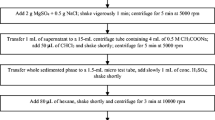Abstract
A method based on microwave-assisted extraction (MAE) was developed to extract lipids from fish for the determination of the fatty acid composition. Microwave-assisted extraction was performed with an open-vessel extraction apparatus similar to the system of Soxhlet. The solvent was an equivolume mixture of ethyl acetate and cyclohexane. The solvent forms a ternary azeotrope with water, and water is separated after re-condensation in a water trap. With this technique, extraction can be performed without pre-drying of fish tissues. After lipid extraction, the esterification was performed with trimethylsulfonium hydroxide (TMSH) and the fatty acid methyl esters (FAMEs) were determined by GC/FID. The results were compared with those obtained after liquid-liquid extraction according to Bligh and Dyer. Fillets of mackerel (Scomber scombrus) and livers of cod (Gadus morhua) were used as the sample material. The water content (n=7) of the cod livers was 36.2±1.6% and that of mackerel fillets was 74.5±0.5%. The lipid contents (n=5) using the MAE method were 5.6±0.4% and 62.6±3.1% in mackerel and cod liver, respectively. Relative levels of 58 fatty acids (two co-eluted) were determined with GC/FID on two capillary columns with different polarity. These were 10 saturated, 24 unsaturated, and 24 unidentified peaks which are most likely unsaturated or branched-chain fatty acids. After MAE the composition of the 57 peaks was virtually the same as that obtained with the Bligh and Dyer method. The advantages are, however, that MAE is faster, requires less solvent, and avoids the use of chlorinated solvents and so is more environmentally friendly. Our results confirm that MAE is a well-suited alternative to the Bligh and Dyer method for the extraction of lipids followed by determination of the fatty acid profile.
Similar content being viewed by others
Author information
Authors and Affiliations
Additional information
Received: 1 March 2000 / Revised version: 23 May 2000
Rights and permissions
About this article
Cite this article
Batista, A., Vetter, W. & Luckas, B. Use of focused open vessel microwave-assisted extraction as prelude for the determination of the fatty acid profile of fish – a comparison with results obtained after liquid-liquid extraction according to Bligh and Dyer. Eur Food Res Technol 212, 377–384 (2001). https://doi.org/10.1007/s002170000240
Issue Date:
DOI: https://doi.org/10.1007/s002170000240




